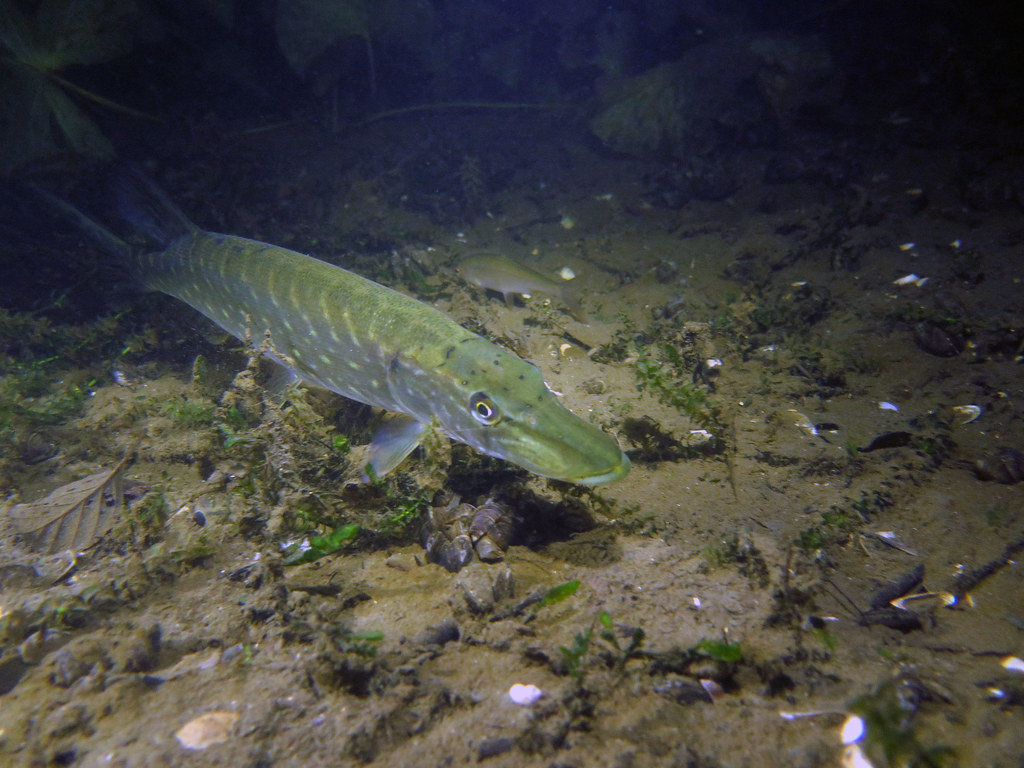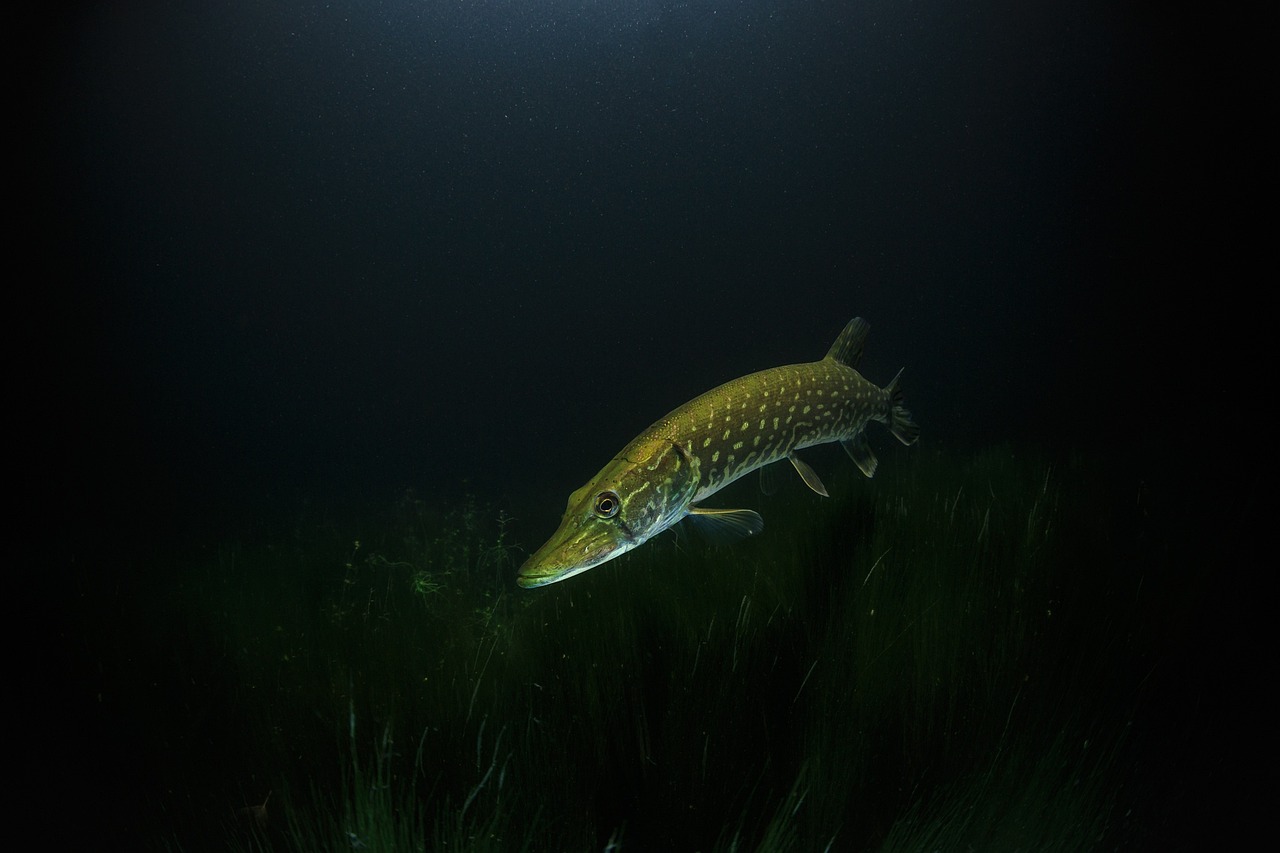Pike
Esox lucius
The fish has a relatively thick, cylindrical and elongated body, having a usual length of 30 – 40 cm, and weighing 0.500 g – 1 kg. But Pike can also grow to a relatively large size, with maximum recorded lengths of up to 150 cm and a weight of 25 kg.
These fish live up to 10–15 years, but specimens have been known to live up to 25 years. Pike are physically capable of breeding at an age of about two years, spawning in spring when the water temperature first reaches about 9 °C. The colour of the roe is yellow, sized 2.5 to 3 mm in diameter, and is a popular delicacy in the local cuisine.
The young fish are able to swim after hatching, but stay on the bottom for some time. The pike is a relatively aggressive species, particularly when it comes to feeding, with cases of cannibalism when food sources are very scarce. Because of this cannibalistic nature, young pike need places where they can take shelter between plants so they are not eaten. Both for hunting and for hiding, rich submerged vegetation is needed.
As a fun fact, in Finland, catching a kymppihauki, a pike weighing at least 10 kg, is considered the qualification as a master fisherman. Also on the topic of pike size, in the Danube and Delta regions, a small pike (usually under 30 cm) also goes by the name of mârlița.

Photographer: katdaned

Photographer: Peyman Zehtab Fard
Acest pește răpitor are un corp relativ gros, cilindric și alungit, adulții având o lungime tipică de 30 – 40 cm și o greutate de 0,500 g – 1 kg. Dar știuca poate crește și la dimensiuni relativ mari, cu lungimi maxime înregistrate de până la 150 cm și o greutate de 25 kg.
Acești pești trăiesc până la 10–15 ani, dar au fost întâlnite exemplare care au trăit până la 25 de ani. Știuca ajunge la vârstă reproducătoare după aproximativ doi ani, depunând icre în primăvară când temperatura apei atinge pentru prima dată 9 °C. Culoarea icrelor este galbenă, având un diametru de 2,5 până la 3 mm, și sunt o delicatesă populară în bucătăria locală.
Peștii tineri sunt capabili să înoate după eclozare, dar rămân pe fundul apei pentru o perioadă de timp. Știuca este o specie relativ agresivă, în special când vine vorba de hrănire, fiind cunoscute chiar cazuri de canibalism atunci când sursele de hrană sunt foarte puține. Din cauza acestor înclinații, știuca tânără are nevoie de locuri unde să se poată adăposti printre plante pentru a nu pica pradă reprezentanților mai mari ai speciei. Vegetație bogată este necesară atât pentru vânătoare, cât și pentru adăpostire.
Ca o curiozitate, în Finlanda, prinderea unui kymppihauki, o știucă care cântărește cel puțin 10 kg, este considerată calificarea pentru statutul de maestru pescar. De asemenea, tot în legătură cu dimensiunea știucii, în regiunile Dunării și Deltei, o știucă mică (de obicei sub 30 cm) poartă și numele de mârlița.
Știucă
Esox lucius
Liede
Esox lucius
Der Fisch hat einen relativ dicken, zylindrischen und langgestreckten Körper mit einer üblichen Länge von 30 – 40 cm und einem Gewicht von 0,500 g – 1 kg. Der Hecht kann aber auch relativ groß werden,
mit einer maximalen Länge von bis zu 150 cm und einem Gewicht von 25 kg.
Diese Fische werden bis zu 10-15 Jahre alt, aber es sind auch Exemplare bekannt, die bis zu 25 Jahre alt werden. Der Hecht ist körperlich in der Lage, sich im Alter von etwa zwei Jahren fortzupflanzen. Er laicht im Frühjahr, wenn die Wassertemperatur erstmals etwa 9 °C erreicht. Der Rogen ist gelb, hat einen Durchmesser von 2,5 bis 3 mm und ist eine beliebte Delikatesse in der lokalen Küche.
Die Jungfische sind nach dem Schlüpfen schwimmfähig, bleiben aber noch einige Zeit auf dem Grund. Der Hecht ist eine relativ aggressive Art, vor allem wenn es um die Nahrungsaufnahme geht, und es kommt zu Kannibalismus, wenn die Nahrungsquellen sehr knapp sind. Wegen dieses Kannibalismus brauchen junge Hechte Unterschlupfmöglichkeiten zwischen den Pflanzen, damit sie nicht gefressen werden. Sowohl für die Jagd als auch für das Verstecken ist eine reiche Unterwasservegetation erforderlich.
Übrigens gilt in Finnland der Fang eines kymppihauki, eines Hechts mit einem Gewicht von mindestens 10 kg, als Qualifikation für einen Meisterangler. Was die Größe des Hechts betrifft, so wird in der Donau und im Deltagebiet ein kleiner Hecht (in der Regel unter 30 cm) auch als “Mârlița” bezeichnet.

Photographer: Argyleist

Photographer: Meinig
Le poisson a un corps relativement épais, cylindrique et allongé, d’une longueur habituelle de 30 à 40 cm et pesant de 0,500 g à 1 kg. Mais le grand brochet peut aussi atteindre une taille relativement grande, avec des longueurs maximales enregistrées allant jusqu’à 150 cm et un poids de 25 kg.
Ces poissons vivent jusqu’à 10 à 15 ans, mais certains spécimens vivent jusqu’à 25 ans. Les grands brochets sont physiquement capables de se reproduire à l’âge d’environ deux ans, frayant au printemps lorsque la température de l’eau atteint pour la première fois environ 9 °C. La couleur des œufs est jaune, d’une taille de 2,5 à 3 mm de diamètre, et est une délicatesse populaire dans la cuisine locale.
Les jeunes poissons sont capables de nager après l’éclosion, mais restent au fond pendant un certain temps. Le grand brochet est une espèce relativement agressive, notamment au niveau de l’alimentation, avec des cas de cannibalisme lorsque les sources de nourriture sont très rares. En raison de cette nature cannibale, les jeunes brochets ont besoin d’endroits où ils peuvent s’abriter entre les plantes pour ne pas être mangés. Tant pour chasser que pour se cacher, une riche végétation submergée est nécessaire.
Brochet
Esox lucius
Try using these colors:
Remember, there are always more colors than you think you see!





